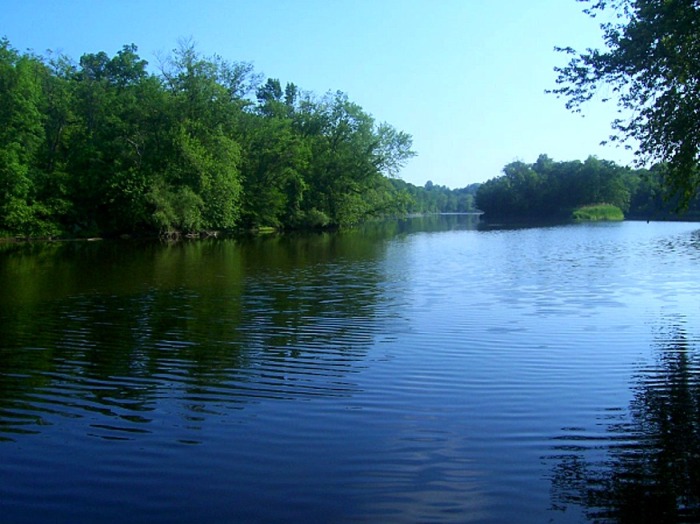 The Wallkill River enters the Hudson Valley from New Jersey through a National Wildlife Refuge, then winds North through the Black Dirt region of Warwick to spread out into the verdant, farm-dappled Wallkill River Valley in Ulster County before meeting with the Rondout Creek and terminating at the Hudson River in Kingston.
The Wallkill River enters the Hudson Valley from New Jersey through a National Wildlife Refuge, then winds North through the Black Dirt region of Warwick to spread out into the verdant, farm-dappled Wallkill River Valley in Ulster County before meeting with the Rondout Creek and terminating at the Hudson River in Kingston.
The river is literally in shit shape. Between dangerous levels of fecal matter and toxic algae blooms the last two summers, the river is not safe to swim in, according to Wallkill River Watershed Alliance Executive Director Jason West and Riverkeeper Water Quality Program Director Dan Shapley.
Riverkeeper, which strives for environmental stewardship of the Hudson River and its tributaries, collected 685 samples from various sites on the Wallkill from 2012 to 2016, and found the vast majority contained unsafe levels of the Enterococcus bacteria, which is found in warm-blooded animal feces.
Yes, feces.
In fact, 87 percent of samples collected in dry periods failed the EPA standards for safe swimming due to the bacteria, while a full 97 percent of samples collected post-rain failed. The EPA threshold for safe swimming is 30 Enterococcus per 100 milliliters of water. On average, the Wallkill had 380.7 per 100 milliliters.
 Shapley of Riverkeeper explained why safe swimming was a good criterion for water quality.
Shapley of Riverkeeper explained why safe swimming was a good criterion for water quality.
“This is one way to assess water quality, and it’s important because it gets to that question of safe swimming — splashing around in the water, anything where you’re likely to get fully immersed in the water or get water in your mouth,” he said.
The quality of water varies widely from point to point along the river. Samples tended to be worse in the Goshen-MIddletown-Montgomery length of the river, though even in the cleanest site sampled — below Sturgeon Pool in Rifton — the majority of the samples showed unsafe levels of the bacteria.
The Enterococcus bacteria isn’t the danger, but it indicates there is fecal matter present, which can carry a host of other dangerous pathogens, Shapley said.
The tests in Riverkeeper’s report don’t source the feces to a particular species, but Shapley said the organization was partnering with Cornell University for a new set of tests enabling them to trace the source to something animal — such as geese droppings or run-off from farms — or something human, such as failing septic systems and sewage systems.
The source of the feces could well be the latter, Shapley said, pointing to aging sewage systems along the Wallkill.
“We have old pipes, old pump stations,” he said.”They did a lot of [work] in sewage infrastructure 40, 50 years ago, a lot of that infrastructure is reaching…the end of its useful life, or it’s past its useful life. We have leaks, we have overflows, the (sewage) plants might be working perfectly well, but if the sewage isn’t reaching the plants — is spilled before it gets there — then you got problems. We suspect that’s part of the story.”
The Wallkill experienced toxic algae blooms the summers of 2015 and 2016, and Wallkill Watershed Alliance’s Jason West said to expect more in the future as global warming continues.

The algae bloom on the Wallkill/Courtesy Wallkill River Watershed Alliance
The blooms led to No Swimming signs being posted due to potential health effects.
“I collected samples last summer, and just wading into the river enough to collect the water samples, my skin was burning and turning red with only a few seconds of contact with the river,” West said.
Along with these immediate effects, prolonged exposure can cause neurological and liver damage, he added.
The blooms consisted of a toxic variation of Cyanobacteria, a naturally occurring organism which can multiply out of control under certain conditions, West said.
The first condition is high levels of nitrogen and phosphorous. Nitrogen exists in increased levels in the environment due to emissions from cars and power plants, but is also a major component, along with phosphorous, of fertilizer.
“For the same reasons [fertilizer] makes the crops grow bigger, it makes its way into the waterways and makes the [Cyanobacteria] in the water grow like crazy,” West said.
The other two factors which make the bacteria thrive, West said, were climate change-related: stagnant water, caused by low rainfall amounts, and higher temperatures.
During the bloom of 2016, which stretched 30 miles, New York was experiencing a drought and the Wallkill was ten feet below average, West said.
The alliance took its own samples to test phosphorus and nitrogen levels along the length of the river, and found the concentrations of the chemicals peaked at the Rio Grande tributary in Goshen, though levels of Phosphates were higher than EPA recommendations at every location sampled, and levels of Nitrogen were higher than EPA recommendations everywhere but at the river’s source in Sparta, New Jersey.
There was little the alliance could do in the short-term to control the blooms through reigning in climate change, West said, but the samples were taken to try to understand how the blooms were being affected on the local level by phosphorus and nitrogen.
The Wallkill can still be enjoyed via boat, such as during the annual New Paltz regatta. Just don’t fall in.



slow moving river = dirty. Ponds are dirty too.
Pingback: Kingston by Kayak | The Other Hudson Valley